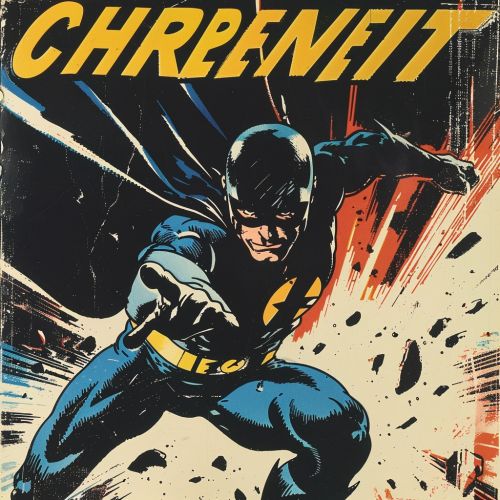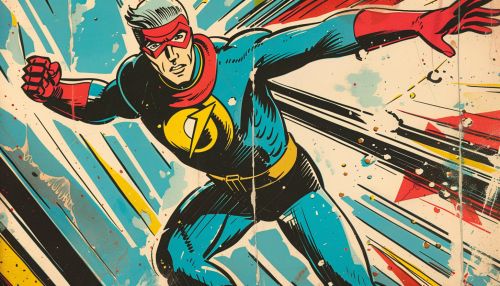Charlton Comics: Difference between revisions
No edit summary |
No edit summary |
||
| Line 14: | Line 14: | ||
* [[Peacemaker]]: Created by writer Joe Gill and artist Pat Boyette, Peacemaker first appeared in "Fightin' 5" #40 in 1966. The character is a pacifist diplomat who uses non-lethal weapons to fight for peace. | * [[Peacemaker]]: Created by writer Joe Gill and artist Pat Boyette, Peacemaker first appeared in "Fightin' 5" #40 in 1966. The character is a pacifist diplomat who uses non-lethal weapons to fight for peace. | ||
[[Image:Detail-79399.jpg|thumb|center|Cover of a Charlton Comics issue featuring a superhero in action.]] | [[Image:Detail-79399.jpg|thumb|center|Cover of a Charlton Comics issue featuring a superhero in action.|class=only_on_mobile]] | ||
[[Image:Detail-79400.jpg|thumb|center|Cover of a Charlton Comics issue featuring a superhero in action.|class=only_on_desktop]] | |||
== Business Model and Production == | == Business Model and Production == | ||
Latest revision as of 08:27, 18 May 2024
History
Charlton Comics was an American comic book publishing company that existed from 1945 to 1986. It was based in Derby, Connecticut, and was a division of Charlton Publications, which also published magazines, puzzle books, and song-lyric magazines. Charlton Comics is notable for its diverse range of genres, including superhero, horror, science fiction, western, and romance comics.
The company was founded by John Santangelo Sr. and Ed Levy. Initially, Charlton focused on publishing song-lyric magazines, but in 1945, they ventured into comic books with the publication of "Yellowjacket Comics." Over the years, Charlton acquired the rights to several defunct comic book publishers, including Fawcett Comics and Quality Comics, which allowed them to expand their library of characters and titles.
Notable Titles and Characters
Charlton Comics is perhaps best known for its superhero characters, many of which were later acquired by DC Comics. Some of the most notable characters include:
- Captain Atom: Created by writer Joe Gill and artist Steve Ditko, Captain Atom first appeared in "Space Adventures" #33 in 1960. The character is a military officer who gains superpowers after being exposed to a nuclear explosion.
- Blue Beetle: The Blue Beetle character has a long history, but the Charlton version, created by Steve Ditko, first appeared in "Captain Atom" #83 in 1966. This version of Blue Beetle is Ted Kord, a genius inventor who uses his skills to fight crime.
- The Question: Another creation of Steve Ditko, The Question first appeared in "Blue Beetle" #1 in 1967. The character is a vigilante journalist who uses a special mask to conceal his identity.
- Peacemaker: Created by writer Joe Gill and artist Pat Boyette, Peacemaker first appeared in "Fightin' 5" #40 in 1966. The character is a pacifist diplomat who uses non-lethal weapons to fight for peace.


Business Model and Production
Charlton Comics was unique in that it operated its own printing press, which allowed it to produce comics at a lower cost than many of its competitors. This was a significant advantage, as it enabled Charlton to sell its comics at a lower price point. The company also employed a number of freelance writers and artists, many of whom would go on to have successful careers in the comic book industry.
One of the most notable aspects of Charlton's business model was its use of a "bullpen" system, where writers and artists would work together in a shared space. This fostered a collaborative environment and allowed for a high level of creative output. Some of the most notable creators who worked at Charlton include Steve Ditko, Dick Giordano, and Denny O'Neil.
Decline and Legacy
By the late 1970s, Charlton Comics began to experience financial difficulties. The comic book industry as a whole was facing a downturn, and Charlton was no exception. In 1985, the company ceased publishing new comics, and in 1986, it sold the rights to its superhero characters to DC Comics.
Despite its relatively short lifespan, Charlton Comics left a lasting impact on the comic book industry. Many of its characters have been integrated into the DC Universe, and its creators have gone on to have significant careers. The company's unique business model and collaborative environment have also been influential in the industry.
